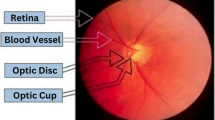Abstract
Glaucoma is a chronic disease resulting in vision loss characterized by gradual damage to the optic nerve. To prevent vision loss, early detection is the key solution that limits this disease. Deep learning algorithms, especially convolutional neural networks (CNNs), have recently demonstrated high robustness in medical image classification tasks. Nevertheless, to achieve this performance, CNNs need to fix the parameters before the training phase. In this paper, we investigate the impact of the batch size on the five fine-tuned pre-trained models for glaucoma detection using fundus images. Our proposal consists of finding the optimal batch size for each model, referred to by OBS. Moreover, to further enhance the performance, we have combined the models using the majority voting method, taking into account the OBS of each one. The results of five challenging datasets show that the ensemble model technique improves the performance of single-use models and outperforms similar state-of-the-arts.
Access this chapter
Tax calculation will be finalised at checkout
Purchases are for personal use only
Similar content being viewed by others
References
Tham, Y.C., Li, X., Wong, T.Y., Quigley, H.A., Aung, T., Cheng, C.Y.: Global prevalence of glaucoma and projections of glaucoma burden through 2040: a systematic review and meta-analysis. Ophthalmology 121(11), 2081–2090 (2014)
Susanna, R., Jr., Vessani, R.M.: Staging glaucoma patient: why and how? Open Ophthalmol. J. 3, 59 (2009)
Abdullah, F., et al.: A review on glaucoma disease detection using computerized techniques. IEEE Access 9, 37311–37333 (2021)
Al-Bander, B., Al-Nuaimy, W., Al-Taee, M.A., Zheng, Y.: Automated glaucoma diagnosis using deep learning approach. In: 2017 14th International Multi-Conference on Systems, Signals & Devices (SSD), pp. 207–210. IEEE (2017)
Christopher, M., et al.: Performance of deep learning architectures and transfer learning for detecting glaucomatous optic neuropathy in fundus photographs. Sci. Rep. 8(1), 1–13 (2018)
Eom, S., Laouar, M.R.: Effects of interaction on e-learning satisfaction and outcome: a review of empirical research and future research direction. Int. J. Inf. Syst. Soc. Change 8(3), 58–71 (2017). https://doi.org/10.4018/IJISSC.2017070105
Bisneto, T.R.V., de Carvalho Filho, A.O., Magalhães, D.M.V.: Generative adversarial network and texture features applied to automatic glaucoma detection. Appl. Soft Comput. 90, 106165 (2020)
Simonyan, K., Zisserman, A.: Very deep convolutional networks for large-scale image recognition. arXiv preprint arXiv:1409.1556 (2014)
Szegedy, C., Vanhoucke, V., Ioffe, S., Shlens, J., Wojna, Z.: Rethinking the inception architecture for computer vision. In: Proceedings of the IEEE Conference on Computer Vision and Pattern Recognition, pp. 2818–2826 (2016)
Chollet, F.: Xception: deep learning with depthwise separable convolutions. In: Proceedings of the IEEE Conference on Computer Vision and Pattern Recognition, pp. 1251–1258 (2017)
Szegedy, C., Ioffe, S., Vanhoucke, V., Alemi, A.A.: Inception-v4, inception-resnet and the impact of residual connections on learning. In: Thirty-First AAAI Conference on Artificial Intelligence (2017)
Budai, A., Bock, R., Maier, A., Hornegger, J., Michelson, G.: Robust vessel segmentation in fundus images. Int. J. Biomed. Imaging 2013, 154860 (2013)
Fumero, F., Alayón, S., Sanchez, J.L., Sigut, J., Gonzalez-Hernandez, M.: RIM-ONE: an open retinal image database for optic nerve evaluation. In: 2011 24th International Symposium on Computer-Based Medical Systems (CBMS), pp. 1–6. IEEE (2011)
sjchoi86: https://github.com/cvblab/retinadataset. Accessed 15 Aug 2021
M. de Economea y Competitividad of Spain - ACRIMA project (TIN2013-46751-R). Acrima database. https://figshare.com/s/c2d31f850af14c5b5232
Sivaswamy, J., Krishnadas, S.R., Joshi, G.D., Jain, M., Tabish, A.U.S.: Drishti-GS: retinal image dataset for optic nerve head (ONH) segmentation. In: 2014 IEEE 11th International Symposium on Biomedical Imaging (ISBI), pp. 53–56. IEEE (2014)
Elangovan, P., Nath, M.K.: Glaucoma assessment from color fundus images using convolutional neural network. Int. J. Imaging Syst. Technol. 31(2), 955–971 (2021)
David, D.S.: Enhanced glaucoma detection using ensemble based CNN and spatially based ellipse fitting curve model. J. Ambient Intell. Human. Comput. 1–12 (2021)
Devecioglu, C., Malik, J., Ince, T., Kiranyaz, S., Atalay, E., Gabbouj, M.: Real-time glaucoma detection from digital fundus images using self-ONNs. IEEE Access 9, 140031–140041 (2021)
Acknowledgments
The authors would like to thank the Agency for Research Results Valuation and Technological Development, Algeria.
Author information
Authors and Affiliations
Corresponding author
Editor information
Editors and Affiliations
Rights and permissions
Copyright information
© 2023 The Author(s), under exclusive license to Springer Nature Switzerland AG
About this paper
Cite this paper
Haouli, IE., Hariri, W., Seridi-Bouchelaghem, H. (2023). Glaucoma Detection Using Optimal Batch Size for Transfer Learning and Ensemble Model Techniques. In: Laouar, M.R., Balas, V.E., Lejdel, B., Eom, S., Boudia, M.A. (eds) 12th International Conference on Information Systems and Advanced Technologies “ICISAT 2022”. ICISAT 2022. Lecture Notes in Networks and Systems, vol 624. Springer, Cham. https://doi.org/10.1007/978-3-031-25344-7_19
Download citation
DOI: https://doi.org/10.1007/978-3-031-25344-7_19
Published:
Publisher Name: Springer, Cham
Print ISBN: 978-3-031-25343-0
Online ISBN: 978-3-031-25344-7
eBook Packages: Intelligent Technologies and RoboticsIntelligent Technologies and Robotics (R0)




